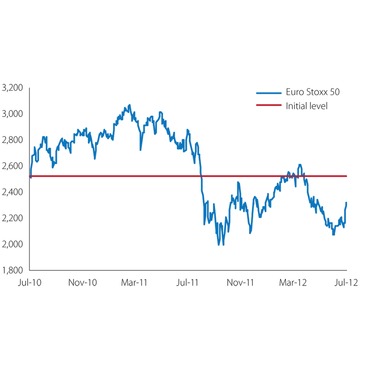
All about the rate
Investing in a euro-based index has worked for US investors as the European currency strengthened against the US dollar, mitigating some of the losses on the direct investment in the index

In September 2010, Citi launched a two-year accelerated growth product linked to the performance of the Euro Stoxx 50 Index, offering US investors a chance to receive returns equal to 1.4 times the index growth at maturity, subject to the US dollar/euro exchange rate. Capital was not protected and investors were fully exposed to any decline in the index. This product could have attracted investors looking to invest in European equities as well as those who might have wanted to hedge against the US dollar weakening against the euro.
Index performance was calculated as the difference between the closing level of the index on the final day of investment and the initial level. If the exchange rate between the dollar and the euro remained the same on the final date as it was on the strike date of the investment, the returns would have been calculated as follows: above the initial level, the investor would have received uncapped returns of 1.4 times index growth in addition to return of capital; below the initial value, investors would have received their capital investment less the fall in the index.
The notional investment was taken in dollars and this amount was used to buy options on the Euro Stoxx 50 in euros. At the end of the product term, the return based on the index performance was converted back into dollars.
The final level of the index was approximately 9% below its initial level, so if this had been a standard quanto product, investors would have been returned 91% of capital at maturity. The final exchange rate increased as the value of the euro strengthened against the dollar, however, which boosted the value of the investment. The amount returned to the investor was worth more than if they had invested in the same index through a product using a quanto currency calculation. If the dollar had weakened against the euro over the term, the final return would be less than just the rise in the index and would be subsequently less than the return from a standard quanto product.
Structured products linked to an index not calculated in the same currency as the product often use the quanto calculation method. This allows investors to buy foreign equities or any underlyings calculated in a different currency without taking on currency risk. This product, however, did not. It therefore left investors exposed to changes in the exchange rate between the dollar and the euro.
The chart illustrates the performance of the Euro Stoxx 50 from the strike date of July 8, 2010 until the product's final valuation date (July 2, 2012). It can be seen that the index had decreased by more than 9% compared to its intitial level on the final date. The exchange rate of the euro to the dollar increased throughout the measurement period by approximately 0.45%, which would have reduced the loss to capital, but only marginally.
To hedge this product, the issuer would have carried out the currency change on the strike and final day of the product so as not to incur any currency risk. They would then hold assets in euros and hedge in the same way as if the product were in dollars.
The Future Value Consultants riskmap rating of this product at the time of pricing was 8.4/10, which is much higher than the ratings for other products released at that time, mostly because there was no downside protection against falls in the index.
Euro Stoxx 50 index performance

Only users who have a paid subscription or are part of a corporate subscription are able to print or copy content.
To access these options, along with all other subscription benefits, please contact info@risk.net or view our subscription options here: http://subscriptions.risk.net/subscribe
You are currently unable to print this content. Please contact info@risk.net to find out more.
You are currently unable to copy this content. Please contact info@risk.net to find out more.
Copyright Infopro Digital Limited. All rights reserved.
As outlined in our terms and conditions, https://www.infopro-digital.com/terms-and-conditions/subscriptions/ (point 2.4), printing is limited to a single copy.
If you would like to purchase additional rights please email info@risk.net
Copyright Infopro Digital Limited. All rights reserved.
You may share this content using our article tools. As outlined in our terms and conditions, https://www.infopro-digital.com/terms-and-conditions/subscriptions/ (clause 2.4), an Authorised User may only make one copy of the materials for their own personal use. You must also comply with the restrictions in clause 2.5.
If you would like to purchase additional rights please email info@risk.net
More on Structured products
A guide to home equity investments: the untapped real estate asset class
This report covers the investment opportunity in untapped home equity and the growth of HEIs, and outlines why the current macroeconomic environment presents a unique inflection point for credit-oriented investors to invest in HEIs
Podcast: Claudio Albanese on how bad models survive
Darwin’s theory of natural selection could help quants detect flawed models and strategies
Range accruals under spotlight as Taiwan prepares for FRTB
Taiwanese banks review viability of products offering options on long-dated rates
Structured products gain favour among Chinese enterprises
The Chinese government’s flagship national strategy for the advancement of regional connectivity – the Belt and Road Initiative – continues to encourage the outward expansion of Chinese state-owned enterprises (SOEs). Here, Guotai Junan International…
Structured notes – Transforming risk into opportunities
Global markets have experienced a period of extreme volatility in response to acute concerns over the economic impact of the Covid‑19 pandemic. Numerix explores what this means for traders, issuers, risk managers and investors as the structured products…
Structured products – Transforming risk into opportunities
The structured product market is one of the most dynamic and complex of all, offering a multitude of benefits to investors. But increased regulation, intense competition and heightened volatility have become the new normal in financial markets, creating…
Increased adoption and innovation are driving the structured products market
To help better understand the challenges and opportunities a range of firms face when operating in this business, the current trends and future of structured products, and how the digital evolution is impacting the market, Numerix’s Ilja Faerman, senior…
Structured products – The ART of risk transfer
Exploring the risk thrown up by autocallables has created a new family of structured products, offering diversification to investors while allowing their manufacturers room to extend their portfolios, writes Manvir Nijhar, co-head of equities and equity…







